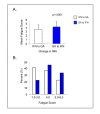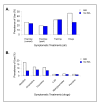Fatigue characteristics in multiple sclerosis: the North American Research Committee on Multiple Sclerosis (NARCOMS) survey
- PMID: 19014588
- PMCID: PMC2596785
- DOI: 10.1186/1477-7525-6-100
Fatigue characteristics in multiple sclerosis: the North American Research Committee on Multiple Sclerosis (NARCOMS) survey
Abstract
Background: Fatigue is a common disabling symptom of multiple sclerosis (MS) and has a significantly negative impact on quality of life. Persons with MS enrolled in the North American Research Committee on Multiple Sclerosis (NARCOMS) Patient Registry are invited to complete follow-up surveys every six months to update their original registration information. One of these surveys was designed to focus on the severity and impact of fatigue, and its association with other clinical parameters of MS such as physical disability.
Methods: In addition to the usual data collected in Registry update surveys such as demographic characteristics, MS-related medical history, disability and handicap, immunomodulatory and symptomatic therapies taken, and healthcare services used, the survey for this study included two validated self-report fatigue scales, the Fatigue Severity Scale (FSS) and the Modified Fatigue Impact Scale (MFIS) and questions about the use of symptomatic management for fatigue, both pharmacologic and non-pharmacologic treatments. This Registry update survey was mailed to all NARCOMS registrants (n = 18,595) in November 2002. Information provided by registry participants was approved for research purposes by the Yale University Institutional Review Board.
Results: The response rate for the survey was 49.5% (9205/18,595). Severe fatigue as measured with the FSS using the developer's recommended severity cutpoint of > or = 36 was reported by 6691 (74%) of evaluable respondents (n = 9077). A higher prevalence of severe fatigue was observed in relapsing-worsening MS compared with relapsing-stable and primary progressive MS. A distinct pattern of fatigue was observed across the disability levels of the Patient-Determined Disease Steps (PDDS). Although there were no differences in the severity or impact of fatigue by immunomodulatory agents (IMA), respondents who recalled therapy changes in the prior six months reported different patterns of change in fatigue with lower fatigue levels reported after changing from interferon-beta to glatiramer acetate than after changing from glatiramer acetate to interferon-beta. Concomitant therapy for fatigue was used by 47.2% of the 5799 survey respondents receiving IMA.
Conclusion: Characterizing MS symptoms like fatigue can increase awareness about their impact on persons with MS and suggest recommendations for a care plan.
Figures



References
-
- Multiple Sclerosis Clinical Practice Guidelines Council . Multiple sclerosis clinical practice guideline. Washington, DC: Paralyzed Veterans Association; 1998. Fatigue and multiple sclerosis: evidence-based management strategies for fatigue in multiple sclerosis.
-
- Freal JE, Kraft GH, Coryell JK. Symptomatic fatigue in multiple sclerosis. Arch Phys Med Rehabil. 1984;65:135–138. - PubMed
-
- Fisk JD, Pontefract A, Ritvo PG, Archibald CJ, Murray TJ. The impact of fatigue on patients with multiple sclerosis. Can J Neurol Sci. 1994;21:9–14. - PubMed
-
- Krupp LB, Alvarez LA, LaRocca NG, Scheinberg LC. Fatigue in multiple sclerosis. Arch Neurol. 1988;45:435–437. - PubMed
Publication types
MeSH terms
Substances
LinkOut - more resources
Full Text Sources
Medical

